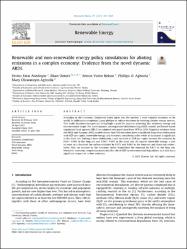Renewable and non-renewable energy policy simulations for abating emissions in a complex economy: Evidence from the novel dynamic ARDL

View/
Date
2021Author
Adedoyin, Festus FataiÖztürk, İlhan
Bekun, Festus Victor
Agboola, Phillips O.
Agboola, Mary Oluwatoyin
Metadata
Show full item recordAbstract
According to the Economic Complexity Index, Japan was the number 1 most complex economy in the
world. In addition to complexity, Japan pledges to reduce emissions by boosting cleaner energy sources.
This study simulates two policies to highlight a path for Japan in achieving this ambitious energy and
environmental target. The novel dynamic autoregressive distribution lag (ARDL) model and Kernel-based
regularized least squares (KRLS) are adopted over panel data from 1970 to 2018. Empirical evidence from
the ARDL and dynamic ARDL models shows that CO2 emissions have a significant long-term relationship
with GDP per capita, renewable energy, and economic complexity index while air transport is significant
in the short run. Putting it more elaborately, a unit increase in GDP per capita increase the emission by
0.84%e0.96% in the long run and 0.46%e0.48% in the short run. As regards renewable energy, a unit
increase in it decrease the carbon emission by 0.07% and 0.04% in the long-run and short-run respectively. Also, an increase in the economic index diminished the emission by 0.81% in the long run.
Moreover, economic complexity moderates the role of GDP in environmental degradation as it also has a
significant impact on carbon emission.
Volume
177Collections
The following license files are associated with this item:

















